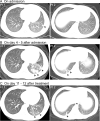Clinical and epidemiological characteristics of pediatric SARS-CoV-2 infections in China: A multicenter case series
- PMID: 32544155
- PMCID: PMC7297312
- DOI: 10.1371/journal.pmed.1003130
Clinical and epidemiological characteristics of pediatric SARS-CoV-2 infections in China: A multicenter case series
Abstract
Background: As of April 18, 2020, over 2,000,000 patients had been diagnosed with coronavirus disease-2019 (COVID-19) globally, and more than 140,000 deaths had been reported. The clinical and epidemiological characteristics of adult patients have been documented recently. However, information on pediatric patients is limited. We describe the clinical and epidemiological characteristics of pediatric patients to provide valuable insight into the early diagnosis and assessment of COVID-19 in children.
Methods and findings: This retrospective, observational study involves a case series performed at 4 hospitals in West China. Thirty-four pediatric patients with COVID-19 were included from January 27 to February 23, 2020. The final follow-up visit was completed by March 16, 2020. Clinical and epidemiological characteristics were analyzed on the basis of demographic data, medical history, laboratory tests, radiological findings, and treatment information. Data analysis was performed for 34 pediatrics patients with COVID-19 aged from 1 to 144 months (median 33.00, interquartile range 10.00-94.25), among whom 14 males (41%) were included. All the patients in the current study presented mild (18%) or moderate (82%) forms of COVID-19. A total of 48% of patients were noted to be without a history of exposure to an identified source. Mixed infections of other respiratory pathogens were reported in 16 patients (47%). Comorbidities were reported in 6 patients (18%). The most common initial symptoms were fever (76%) and cough (62%). Expectoration (21%), vomiting (12%), and diarrhea (12%) were also reported in a considerable portion of cases. A substantial increase was detected in serum amyloid A for 17 patients (among 20 patients with available data; 85%) and in high-sensitivity C-reactive protein for 17 patients (among 29 patients with available data; 59%), whereas a decrease in prealbumin was noticed in 25 patients (among 32 patients with available data; 78%). In addition, significant increases in the levels of lactate dehydrogenase and α-hydroxybutyrate dehydrogenase were detected in 28 patients (among 34 patients with available data; 82%) and 25 patients (among 34 patients with available data; 74%), respectively. Patchy lesions in lobules were detected by chest computed tomographic scans in 28 patients (82%). Ground-glass opacities, which were a typical feature in adults, were rare in pediatric patients (3%). Rapid radiologic progression and a late-onset pattern of lesions in the lobules were also noticed. Lesions in lobules still existed in 24 (among 32 patients with lesions; 75%) patients that were discharged, although the main symptoms disappeared a few days after treatment. All patients were discharged, and the median duration of hospitalization was 10.00 (8.00-14.25) days. The current study was limited by the small sample size and a lack of dynamic detection of inflammatory markers.
Conclusions: Our data systemically presented the clinical and epidemiological features, as well as the outcomes, of pediatric patients with COVID-19. Stratified analysis was performed between mild and moderate cases. The findings offer new insight into early identification and intervention in pediatric patients with COVID-19.
Conflict of interest statement
The authors have declared that no competing interests exist.
Figures




References
-
- WHO [Internet]. Novel coronavirus (2019-nCoV) situation report-11 [cited 2020 Apr 18]. Available from: https://www.who.int/docs/default-source/coronaviruse/situation-reports/2....
-
- WHO [Internet]. Coronavirus disease 2019 (COVID-19) situation report-89 [cited 2020 Apr 19]. Available from: https://www.who.int/docs/default-source/coronaviruse/situation-reports/2....
Publication types
MeSH terms
Substances
LinkOut - more resources
Full Text Sources
Research Materials
Miscellaneous

